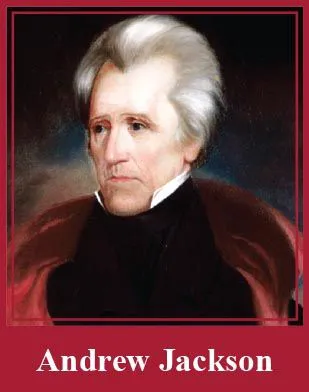| 1824 | - Ideological and policy differences reemerge as multiple Republican candidates vie for the presidency.
- The subsequent realignment will result in the Second Party System of Jacksonian Democrats versus the Whigs.
- John Quincy Adams is elected president.
- The election is decided in the House of Representatives when no candidate wins an electoral majority.
- Andrew Jackson, winner of the popular vote, charges that Adams secured his office through a “corrupt bargain” when Speaker of the House Henry Clay is named secretary of state.
- In Gibbons v. Ogden, the Supreme Court strikes down the monopoly granted by NY to a steamboat company, holding that the Commerce Clause gives Congress the sole power to regulate interstate commerce.
|
| 1825 | - President Adams proposes an expansive program of internal improvements, including a national university, a national observatory, and the adoption of the metric system, as well as the construction of roads and canals.
- The Erie Canal is completed, linking the Great Lakes across NY to the Hudson River and New York City.
- The project is funded with state and private investments.
- It is the most successful canal of the era, making a profit before completion.
- Transportation costs plummet, inspiring a “canal craze” as other communities attempt to copy the canal’s success.
|
| 1826 | The disappearance and presumed murder of apostate Freemason William Morgan touches off an anti- Mason movement. - The Anti-Masonic Party is formed in 1828 to oppose the perceived political influence of Freemasonry.
- Though short-lived, the party introduces innovations such as the nominating convention.
|
| 1828 | - Congress passes the Tariff of 1828 (a.k.a. Tariff of Abominations), a protective tariff.
- Andrew Jackson (D-TN) is elected president.
- Construction begins on the Baltimore and Ohio Railroad.
- John C. Calhoun expounds the doctrine of nullification in his “South Carolina Exposition and Protest,” provoking the Nullification Crisis.
- He argues that states may judge the constitutionality of federal laws and declares the Tariff of 1828 null and void because it favors northern manufacturing at the expense of southern agriculture.
|
| 1829 | President Jackson begins the so-called spoils system of appointing federal officials. - Jackson defends the system as a “rotation in office,” preventing corruption.
- Still, the chief criterion for selection is loyalty to Jackson.
|
| 1830 | - In the Webster-Hayne Debates over tariff policy, senators Daniel Webster (MA) and Robert Y. Hayne (SC) examine the nature of the union, the power of the states, and the structure of federalism.
- The Indian Removal Act forces the migration of southeastern Indians to OK.
- Jackson vetoes the Maysville Road Bill as unconstitutional, arguing that it would use federal funds for a project located within one state only.
|
| 1831 | - The Peggy Eaton affair (a.k.a. Petticoat affair) challenges Jackson’s new administration as wives of cabinet officers refuse to associate with reputed adulteress Peggy Eaton, wife of the secretary of war.
- To save face, all cabinet officers are forced to resign; afterward, Jackson convenes the Kitchen Cabinet, a group of unofficial advisors.
- Nat Turner leads a slave rebellion in VA.
|
| 1832 | - The Bank War commences.
- Presidential candidate Henry Clay and SBUS president Nicholas Biddle attempt to recharter the SBUS four years early.
- They hope to use the impending presidential election to corner Jackson, who was extreme in his anti-SBUS views.
- Jackson vetoes the recharter bill despite the popularity of the SBUS.
- Jackson is reelected, having persuaded people to accept his position.
- In Worcester v. Georgia, the Supreme Court rules that GA laws do not apply to Cherokee lands, since, according to Justice Marshall, the Cherokee are a “domestic dependent nation.”
- Jackson pushes for removal anyway.
- The Tariff of 1832 is passed.
- In the Blackhawk War, U.S. forces clash with Indians in the upper Midwest near the Mississippi River.
|
| 1833 | - Congress enacts the Force Bill, authorizing the president to use the military to collect federal duties in SC.
- Congress passes the Tariff of 1833, providing for the gradual lowering of tariffs.
- SC accepts the compromise, ending the Nullification Crisis.
- Still, SC votes to nullify the Force Bill to save face.
- Britain abolishes slavery in its colonies.
|
| 1834 | Anti-Jackson forces coalesce into the Whig Party. |
| 1835 | - The U.S. pays off the national debt for the first and only time in history.
- The Second Seminole War begins in FL.
- Controversy erupts over whether the U.S. Post Office is obligated to deliver abolitionist tracts in the South.
|
| 1836 | - Martin Van Buren is elected president.
- The Texas Revolution begins as Texans declare independence from Mexico.
- Mexican forces defeat TX forces at the Alamo.
- General Sam Houston defeats the Mexican army at the Battle of San Jacinto, securing independence for TX.
- Congress adopts a Gag Rule, which prevents the consideration of abolitionist petitions.
- The Specie Circular is issued, requiring large purchases of federal lands to be made in gold or silver coin.
- It is intended to thwart speculators and keep lands open for small-scale farmers, but it backfires by constricting the money supply, scaring capital markets.
|
| 1837 | - Economic hard times follow the Panic of 1837, which is brought on by uncertainty in banking and changes in international credit markets.
- In Charles River Bridge v. Warren Bridge, the Supreme Court weakens monopoly claims granted by corporate charters.
|
| 1838 | The Trail of Tears begins, leading to the deaths of more than 4,000 Indians forcibly removed westward. |
| 1839 | The Panic of 1839 plunges an already weak economy into a deep recession lasting until 1843. |
| 1840 | Mimicking Democrat tactics, Whig William Henry Harrison (OH) ... |



